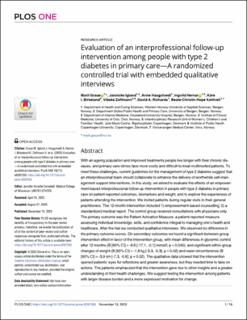Evaluation of an interprofessional follow-up intervention among people with type 2 diabetes in primary care—A randomized controlled trial with embedded qualitative interviews
Graue, Marit; Igland, Jannicke; Haugstvedt, Anne; Hernar, Ingvild; Birkeland, Kåre Inge; Zoffmann, Vibeke; Richards, David A; Kolltveit, Beate-Christin Hope
Peer reviewed, Journal article
Published version
Permanent lenke
https://hdl.handle.net/11250/3112859Utgivelsesdato
2023Metadata
Vis full innførselSamlinger
- Import fra CRIStin [3604]
- Institutt for helse- og omsorgsvitskap [2776]
Originalversjon
10.1371/journal.pone.0291255Sammendrag
With an ageing population and improved treatments people live longer with their chronic diseases, and primary care clinics face more costly and difficult-to-treat multimorbid patients. To meet these challenges, current guidelines for the management of type 2 diabetes suggest that an interprofessional team should collaborate to enhance the delivery of worthwhile self-management support interventions. In this study, we aimed to evaluate the effects of an empowerment-based interprofessional follow-up intervention in people with type 2 diabetes in primary care on patient-reported outcomes, biomarkers and weight, and to explore the experiences of patients attending the intervention. We invited patients during regular visits to their general practitioners. The 12-month intervention included 1) empowerment-based counselling; 2) a standardized medical report. The control group received consultations with physicians only. The primary outcome was the Patient Activation Measure, a patient-reported measure assessing individual knowledge, skills, and confidence integral to managing one’s health and healthcare. After the trial we conducted qualitative interviews. We observed no difference in the primary outcome scores. On secondary outcomes we found a significant between-group intervention effect in favor of the intervention group, with mean differences in glycemic control after 12 months (B [95% CI] = -8.6 [-17.1, -0.1] mmol/l; p = 0.045), and significant within-group changes of weight (B [95% CI] = -1.8 kg [-3.3, -0.3]; p = 0.02) and waist circumference (B [95% CI] = -3.9 cm [-7.3, -0.6]; p = 0.02). The qualitative data showed that the intervention opened patients’ eyes for reflections and greater awareness, but they needed time to take on actions. The patients emphasized that the intervention gave rise to other insights and a greater understanding of their health challenges. We suggest testing the intervention among patients with larger disease burden and a more expressed motivation for change.

